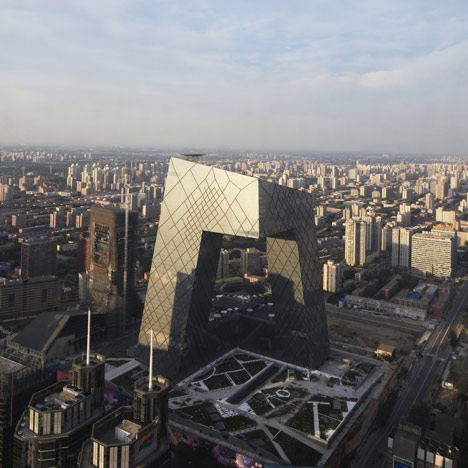News: ten years after declaring he wanted to "kill the skyscraper", architect Rem Koolhaas has accepted an award for the best tall building of the year and joked: "my campaign was completely unsuccessful".
Koolhaas, founding partner of OMA, received the award for Best Tall Building Worldwide from the Council on Tall Buildings and Urban Habitat (CTBUH) in Chicago today for CCTV Headquarters in Beijing, China.
Completed in 2012, the looping CCTV building was a deliberate assault on the cliched form of most skyscrapers. OMA won a competition to design the building in 2002 and the following year it featured on the cover of Koolhaas' book Content, which contained a chapter titled Kill the Skyscraper.
“When I published my last book, Content, in 2003, one chapter was called ‘Kill the Skyscraper,’” said Koolhaas, in a presentation about the project to CTBUH.
“Basically it was an expression of disappointment at the way the skyscraper typology was used and applied. I didn’t think there was a lot of creative life left in skyscrapers. Therefore, I tried to launch a campaign against the skyscraper in its more uninspired form."
He added: “The fact that I am standing on this stage now, in this position, meant that my declaration of war went completely unnoted, and that my campaign was completely unsuccessful."
“Being here, it is quite moving - to be part of a community that is trying to make skyscrapers more interesting," Koolhaas concluded. "I am deeply grateful, and thank all my partners.”
CTBUH said of the building: "The CCTV headquarters is an unusual take on the skyscraper typology. Instead of competing in the race for ultimate height and style through a traditional two-dimensional tower soaring skyward, CCTV’s loop poses a truly three-dimensional experience, culminating in a 75-meter cantilever."
In Content, Koolhaas argued that skyscrapers as a genre had been reduced to a vacuous race for height. He wrote that "the skyscraper has become less interesting in inverse proportion to its success. It has not been refined, but corrupted."
Here's the press release from CTBUH:
CHICAGO, November 8— The Council on Tall Buildings and Urban Habitat (CTBUH) has announced the winner of its Best Tall Building Worldwide: CCTV Headquarters, Beijing, China. As part of a nearly year-long juried selection process across more than 60 entries, the Awards Jury first selected a Best Tall Building in four regions: the Americas, Middle East and Africa, Europe and Asia & Australasia. Senior representatives of each of these four winners then gave a presentation at the CTBUH Awards Symposium Nov. 7 at the Illinois Institute of Technology, Chicago, with the Jury convening immediately afterwards. The winner was announced by Wiel Arets, Dean of the School of Architecture at IIT, at the Awards Dinner following the Symposium.
Rem Koolhaas, Founding Partner, Office for Metropolitan Architecture, delivered the winning presentation, entitled “A New Typology for the Skyscraper: CCTV Headquarters, Beijing.”
“When I published my last book, Content, in 2003, one chapter was called ‘Kill the Skyscraper,’” said Koolhaas, who received the award for CCTV. “Basically it was an expression of disappointment at the way the skyscraper typology was used and applied. I didn’t think there was a lot of creative life left in skyscrapers. Therefore, I tried to launch a campaign against the skyscraper in its more uninspired form.
“The fact that I am standing on this stage now, in this position, meant that my declaration of war went completely unnoted, and that my campaign was completely unsuccessful,” Koolhaas joked, concluding, “Being here, it is quite moving - to be part of a community that is trying to make skyscrapers more interesting. I am deeply grateful, and thank all my partners.”
“I thought [making the decision] would be pretty straightforward, and it was not at all,” said CTBUH Executive Director Antony Wood, a 2013 awards juror. “It went through four rounds of voting before we decided on the winner.”
The audience vote, taken separately, submitted via text message, and kept from their jury’s view until after their verdict had been announced, was the same.
About CCTV Headquarters:
The CCTV headquarters is an unusual take on the skyscraper typology. Instead of competing in the race for ultimate height and style through a traditional two-dimensional tower soaring skyward, CCTV’s loop poses a truly three-dimensional experience, culminating in a 75-meter cantilever.
Conflating expectations of what a skyscraper is, and can or should do, the CCTV Headquarters has now become embedded in the thought process of the making of tall buildings. It singlehandedly paved the way from the height-obsessed, set-back skyscraper of the past to the sculptural and spatial skyscraper of the present, at the scale of the urban skyline. Its stunning form, which appears both powerful and conflicted, as if pulled in several directions, symbolizes the multiple functions of the program and the dynamic positioning of its nation on the world stage. The unique architectural design contrasts significantly with historical building styles in Beijing, yet it could never be classified as a homogenizing force.
As a piece of structural engineering, CCTV is also an object lesson for those who wish to push the boundaries and sweep aside the received notions of skyscraper design. The building’s design violates conventions, while validating and rewarding intensive and focused collaboration and study.

